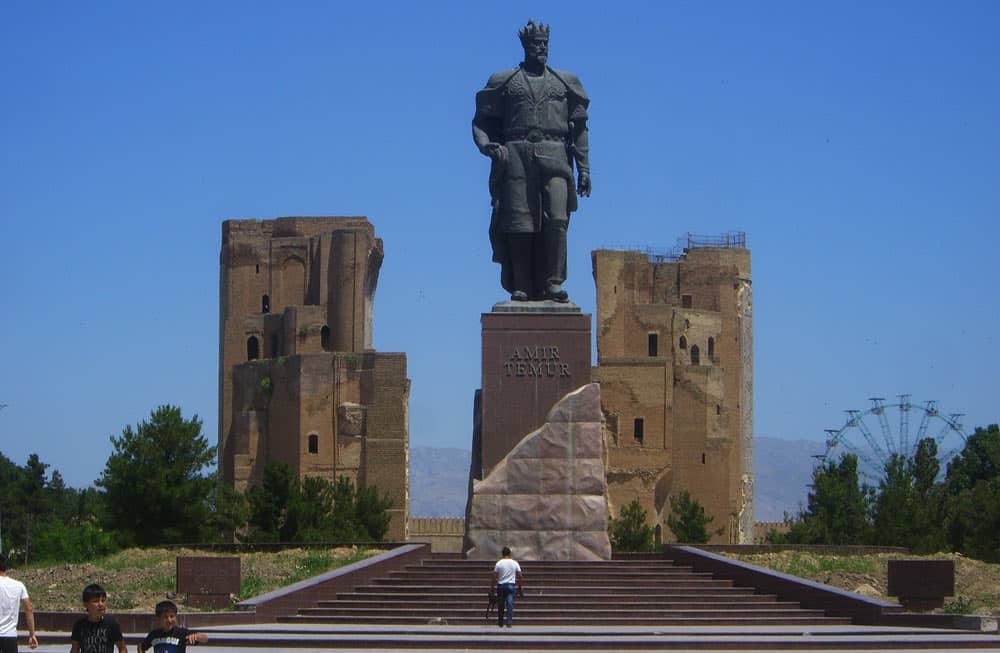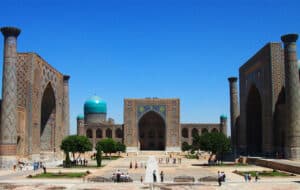Gur-e-Amir Mausoleum Travel Guide
1. Introduction
Gur-e-Amir (sometimes spelled Guri Amir) translates to “Tomb of the Commander,” referencing its most famous occupant: the legendary conqueror Timur—also known as Tamerlane. Built in the early 15th century, this mausoleum is widely regarded as the spiritual and dynastic resting place of the Timurid line. Its striking azure dome, intricate tilework, and storied past make Gur-e-Amir an unmissable highlight of Samarkand.
Historical Quote
“Where Timur lies, the heavens bow lower, and the stones speak of glory untarnished by time.”
– A 15th-century court poet describing the mausoleum’s prestige.
2. A Glimpse into Its Past
Commission & Construction
- Origin of the Mausoleum: Intended initially as the burial place for Timur’s grandson, Muhammad Sultan, Gur-e-Amir later became the resting place for Timur himself following his unexpected death en route to China in 1405.
- Dynastic Significance: Several important Timurid princes, including Ulugh Beg, are also interred here, making Gur-e-Amir not just a single tomb but a family mausoleum symbolizing the Timurid era’s power.
Intriguing Historical Facts
- “Curse of Tamerlane”: A local legend holds that the opening of Timur’s tomb in 1941 by Soviet anthropologists supposedly coincided with the Nazi invasion of the USSR, spawning tales of a “curse.” It remains an oft-recounted piece of local lore.
- Shift in Timurid Architecture: Gur-e-Amir’s design influenced the later architectural masterpieces of Central Asia and even inspired elements of Mughal structures in India—particularly Humayun’s Tomb in Delhi and the Taj Mahal in Agra.
- Ulugh Beg’s Contribution: Timur’s brilliant grandson oversaw part of the construction and decoration, blending astronomy-inspired motifs in the mausoleum’s interior design.
3. Architectural Highlights
The Exterior
- Iconic Dome:
- Azure & Ribbed: The bright blue, ribbed dome is a hallmark of Timurid design. It’s adorned with geometric patterns that catch the sunlight and showcase a mesmerizing interplay of shapes.
- Height & Proportions: Although the dome isn’t the largest in Samarkand, its proportions create an elegant silhouette that has become one of the city’s most recognized sights.
- Intricate Portal (Peshtak):
- Ceramic Tiles & Muqarnas: The grand entrance is decorated with multi-hued ceramic tiles, forming floral and geometric patterns. Decorative muqarnas (stalactite-like ornamentation) frame the gateway.
- Calligraphy: Look for passages in ornate Arabic script—Quranic verses extolling the fleeting nature of life and the grandeur of the Divine.
The Interior
- Gilded and Ornamental Chamber:
- Gold Leaf & Paint: Lavish use of gold leaf and paint covers the walls, arches, and dome interior—creating a celestial atmosphere in the softly lit mausoleum.
- Astronomical Motifs: Ulugh Beg, an accomplished astronomer, may have influenced certain star-like decorations that hint at the Timurid fascination with the cosmos.
- Sepulchers & Marble Slabs:
- Central Sarcophagus: Timur’s tomb is marked by a dark-green jade slab (long considered one of the world’s largest jade pieces). Other Timurid princes lie in surrounding tombs.
- Symbolism: While you see raised sarcophagi in the chamber, the actual burials rest in a crypt below, a traditional practice in Central Asian royal mausoleums.
4. Photography Tips: Timing & Angles
4.1 When to Shoot
- Morning Light (8:00–10:00 AM)
- Soft Illumination: Ideal for capturing the blue dome against a calmer sky with fewer reflections.
- Fewer Crowds: Less chance of people appearing in your frame during these quieter hours.
- Late Afternoon/Golden Hour (4:00–7:00 PM, season-dependent)
- Warm Tones: The dome and tiled portal glow with golden highlights, offering a striking contrast with the deep turquoise.
- Intriguing Shadows: Low-angle sunlight can create dramatic patterns on the mausoleum’s facade.
4.2 Angles & Techniques
- Wide-Angle Shots:
- Capture the Full Facade: A wide lens helps showcase the entire portal, dome, and courtyard in one frame.
- Use Leading Lines: Position yourself along the walkway leading to the mausoleum, drawing the viewer’s eye toward the central structure.
- Close-Ups & Details:
- Tilework & Calligraphy: Zoom in on the repeating geometric patterns and intricate inscriptions—each tile can be a small masterpiece of craftsmanship.
- Interior Gilded Details: If allowed, using a fast lens or higher ISO helps capture the dimly lit interior without flash (flash can be prohibited in some areas).
- Reflections & Creative Framing:
- Reflective Surfaces: After rain, puddles in the courtyard can mirror the dome—an excellent opportunity for symmetrical shots.
- Portal Framing: Stand inside the portal arch for a framed perspective of the dome or the courtyard.
4.3 Practical Tips
- Tripods: Generally permissible outside the mausoleum; check with staff for any indoor restrictions.
- Respect the Sacred Space: Be discreet with cameras inside the mausoleum chamber, as it remains a pilgrimage site and place of reverence.
- Bracketing/HDR: The high contrast between bright exteriors and dim interiors might warrant blending exposures.
5. Visiting Logistics
Opening Hours & Tickets
- Hours: Typically 8:00 AM–7:00 PM, though they may vary seasonally or for religious events.
- Entry Fee: Ranges around 25,000–40,000 UZS for foreign visitors; locals and students might pay a reduced rate.
- Ticket Booth: Usually near the main entrance. Keep your ticket handy if you plan to leave and re-enter.
Getting There
- Taxi: Quick and direct from Samarkand’s city center; fares are inexpensive.
- By Foot: If you’re already near the Registan or Bibi-Khanym Mosque, Gur-e-Amir is about a 10- to 15-minute walk—just be mindful of summer heat.
- Public Transport: Some local buses or shared minibuses stop nearby, but they can be less predictable. Taxis are the most convenient option.
6. Cultural & General Tips
- Dress Modestly: Out of respect for this historical and spiritual site, covering shoulders and knees is appreciated.
- Quiet Reflection: Locals and pilgrims often visit to pay respects to Timur’s tomb. Maintain a low voice, and avoid disruptive behaviors.
- Watch Your Step: Some steps and pathways may be worn or uneven due to centuries of foot traffic.
- Engage a Local Guide: A guide can tell rich stories about Timur’s life, the curse legend, and architectural facts you won’t find in guidebooks.
7. Nearby Attractions
- Registan Ensemble: Samarkand’s most renowned complex, featuring three majestic madrasahs (Ulugh Beg, Sher-Dor, Tilya-Kori).
- Bibi-Khanym Mosque: Another Timurid masterpiece, once among the largest mosques in the Islamic world.
- Shah-i-Zinda Necropolis: A hillside avenue of mausoleums, celebrated for its lavish tilework and spiritual reverence.
- Siab Bazaar: A vibrant market where you can taste local specialties like freshly baked bread (non) and purchase spices, nuts, and dried fruits.
8. Conclusion
Gur-e-Amir Mausoleum stands at the crossroads of Timurid heritage, artistic triumph, and mythic legend. From the azure dome’s elegance to the hushed serenity of Timur’s final resting place, the mausoleum offers a poignant glimpse into Samarkand’s golden age. Whether you’re drawn by the architectural splendor, the tales of dynastic glory, or simply the desire to photograph one of Central Asia’s most revered sites, Gur-e-Amir delivers a haunting beauty that resonates through time.
Parting Thought
“In the shadow of Timur’s tomb, one senses both the fleeting nature of earthly empire and the enduring power of sublime artistry.”
– A 16th-century observer, remarking on Gur-e-Amir’s legacy
Plan your shots, respect the quiet grandeur, and let Gur-e-Amir’s blend of history and craftsmanship leave an indelible mark on your Samarkand journey.
Related Tours







